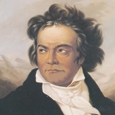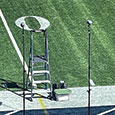The Symphony No. 9 in D minor, Opus 125, has earned a place in music history as one of the most important orchestral works. Completed in 1824, it was the last symphony composed by Beethoven before his death. The symphony was groundbreaking and influential in many ways. In the fourth movement, Beethoven set Friedrich Schiller’s poem Ode to Joy for the soloists and chorus. This was the first use of a chorus and vocal soloists in a symphony. The poem, completed in 1785 and revised in 1803, was one of Beethoven’s favorites.
The work is over an hour in length and scored for two flutes and one piccolo. The piccolo player does not play until quite late in the finale (4th movement), and this first entrance is soloistic. Often the principal flute will ask the piccolo player to play some tutti sections on flute as the principal part is physically taxing. In addition, there are many loud sections where the piccoloist can double the parts at the octave on piccolo to stay warmed up and in tune with the orchestra. (See The Waiting Game. Flute Talk, September, 2009).
The piccolo’s first entrance is at the Allegro assai: vivace alla Marcia section, commonly referred to as the Turkish March. This musical interlude happens as the tenor soloist sings a variation on the Ode to Joy theme over the top of the instruments. In reality, it is more a generic march with the instrumentation (trumpet, clarinet, piccolo, triangle, cymbals and bass drum) giving the Turkish flavor to the melodic variation.
The 17th and 18th centuries saw a fascination with all things Turkish in Europe, including the music. Many compositions featured sections marked Alla Turca, and Mozart’s entire opera, the Abduction from the Seraglio, is themed around stereotypes of sinister Turks. Turkish marches are always in duple meter and percussion instruments are to the fore. The piccolo is thought to mimic the sounds of the zuma (shawn) important in Janissary military music of the Ottoman empire.
.jpg)
The solo begins softly and should sound distant. To keep the sound martial, do not sustain all the way through the dotted quarter note ties. I use the fingering TH 0234/0234 for the high D in measure 351 and in subsequent measures to keep the pitch high enough; otherwise this tends to be a rather low-pitched note on the piccolo, especially at softer dynamic levels. This theme continues to build in dynamic, ending at a forte level.
The piccolo has a short tacet and come in two bars before the penultimate prestissimo. Check the pitches carefully in bar 870. The part from the Breitkopf & Hartel edition shows a G on the downbeat while the newer Barenreiter edition (by Jonathan del Mar) shows an F#. The score has an F#.

Throughout this prestissimo, there are quite a few repetitious measures. Concentrate and keep your eyes moving forward so you move through the repetitions rather than getting stuck. One suggestion is to mark each repeated figure with a number to help you keep track.

The final page of the symphony is packed with opportunities for powerful playing. Use plenty of air to project the tone on top of a very full orchestral texture. Keep the embouchure relaxed so you are not holding or squeezing out the tone, rather allow the tone to move out of the mouth and into the performance space. As it is quite loud, I use earplugs when I practice this part as well as in actual performance. Practice taking very quick breaths for the extremely fast tempo at the end.
I look forward to performing this thrilling symphony every time it is programmed. The piccolo plays a small but important role in Beethoven’s symphonies, debuting in the 5th symphony (the first time piccolo was used) and portraying thunder and lightning in the 6th. Its colorful contributions in the 9th lend sparkle and excitement to the finale.






